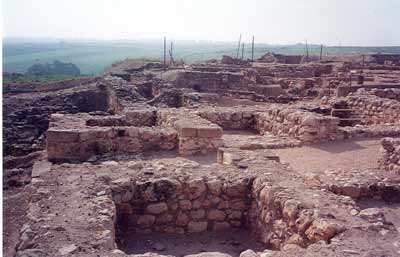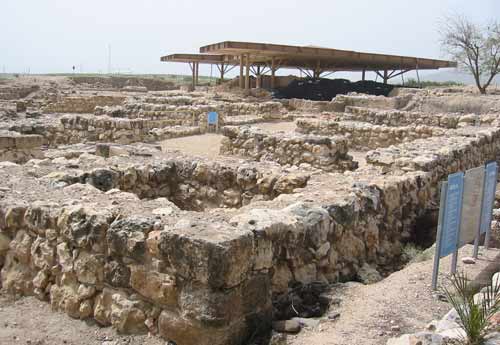
Hazor - March 1999

Hazor - April 2005
Israeli archaeologist Yigael Yadin dug up Hazor (1955-58).
He discovered the six chamber gate complex and dated it to the time of
Solomon. The six chambers were behind two square buttresses at the
entrance to the city.
This discovery was of interest for it was written in
the Bible that Solomon had building projects in Hazor, Megiddo, and
Gezer.
1Kings 9:15 "And this is the reason of the levy
which king Solomon raised, to build the house of Jehovah (YHWH), and his
own house, and Millo, and the wall of Jerusalem, and Hazor, and
Megiddo, and Gezer."
Yigael Yadin had dated one gate structure at Megiddo
to the time of Solomon. He also wrote about one of the gates at
Gezer as being from the time of Solomon (IEJ
Reader Vol I, "Solomon's City Wall and Gate at Gezer,", Y. Yadin, 1981).
Yigael recorded the orientation of
the three gates (Hazor, Megiddo, and Gezer) were from the same plan
built to slightly different specifications as if "planned by the same royal
architect."
Recent excavations and study of Megiddo used C-14 dating to date the
triple gate at Megiddo to after the time of Solomon. The stories of
Solomon were likely folk lore as it is difficult to accept any ruler of
that day had 700 wives and 300 concubines (1 Kings 11:13). The story
of David and Goliath is doubtful as Goliath was listed as being over nine
feet tall (1 Samuel 17:4). Some scholars have found likely
anachronisms in the stories of David and Solomon. During the 8th century
BC there was an Assyrian account in writing about King
Tiglath-Pileser III collecting tribute from Hiram of Tyre, Menaham of
Samaria, and Queen Zebibe of Arabia (Queen of the South?). The 8th
century BC Judean king Jotham lived during this era and had a seaport on the Red Sea.
Solomon may have lived in the 10th century BC. There was a stone
coffin found at Byblos on the Med. coast of Ahiram. Albright dated
this to the 10th century, others dated it earlier. The coffin of
Ahiram was used as evidence for a relationship between Solomon and
Hiram. Earlier theories that Solomon
had a seaport on the Red Sea could not be substantiated. Stories
about Philistines living in their cities along the southern coastal plain
of Israel have
been proven by archaeologists and historians. They used a decorated Eastern Med. pottery
similar to that used in the Greek Isles and Crete during those days.
This potter was unique and unlike the plain pottery being
used in the hill country of Israel during the eleventh and tenth centuries
B.C.
Solomon was likely a ruler of Israel whose works were exaggerated after
much time elapsed and records were missing.
See also:
The Bible and Radiocarbon Dating, Levy and Higham,
Equinox, 2005
Nelson Glueck's 1938-1940 Excavations at Tell El-Kheleifeh A Reappraisal,
Gary D. Pratico, ASOR. 1993
David and Solomon, In Search of the Bible's Sacred Kings and the Roots of
the Western Tradition, Israel Finkelstein and Neil Asher Silberman, Free
Press/Simon and Schuster, 2006
Megiddo III, The 1992-1996 Seasons, Israel Finkelstein, David Ussishkin,
and Baruch Halpern (Editors), Tel Aviv, 2000
Megiddo IV, The 1998-2000 Seasons, Israel Finkelstein, David Ussishkin,
and Baruch Halpern (Editors), Tel Aviv, 2006
|